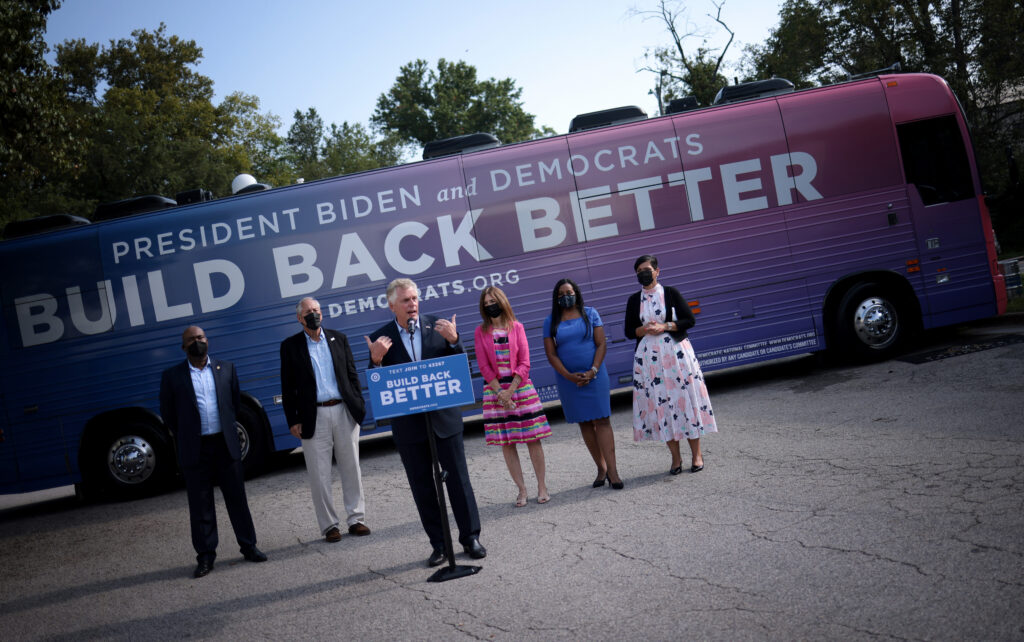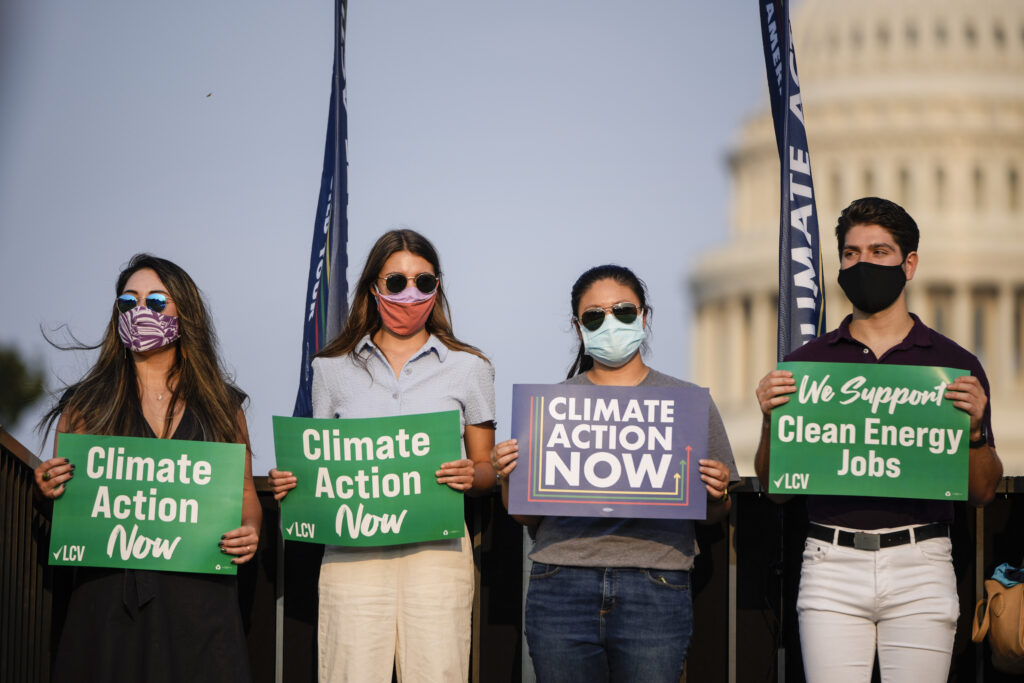In the next month, a bitterly divided US Congress is poised to determine not only the fate of the core of the Biden Administration’s domestic agenda, but whether the US will finally begin to move away from the era of market fundamentalism and into a new period of reconstruction. The outcome is also likely to have significant effect on whether Democrats consolidate or lose their hold on the Congress in the upcoming 2022 midterm elections. The legislative scramble centers around two major pieces of legislation: a bipartisan infrastructure bill and what the administration dubs the “Build Back Better” budget reconciliation package. Both are slated to be voted on before the end of the fiscal year on September 30.
The following briefly outlines context for the administration’s initiatives, the elements of Biden’s “Build Back Better” agenda, the political obstacles to reform, the arcane legislative rules that must be navigated, and implications for the ongoing political brawl.
Biden and the Roosevelt Moment
One of Joe Biden’s first acts in office was to hang a portrait of Franklin Roosevelt in place of Donald Trump’s choice of Andrew Jackson, a slave owning president in the 19th century. Then, against all expectations, Biden set out to meet the challenges of what he called an “FDR moment,” seeking to marshal the resources of government to address the “cascading crises” we face—the pandemic, extreme inequality and a declining middle class, entrenched racial disparities, catastrophic climate change, and a corrupted democracy—with the most ambitious agenda in half a century.
The bankruptcy of the old consensus is apparent. Even Joe Biden, a career politician known for tacking with conservative currents, realized that the US needs bold reform. His domestic plan is audacious compared to the past, if inadequate to the challenge. His plan also must overcome partisan obstruction, entrenched corporate and financial interests, and internal Democratic party divisions in the midst of an economy struggling to recover from the pandemic shutdown, a climate crisis, a democracy under siege, and continued racial upheaval.
His break with the conservative era of the last four decades is clear. He has called for major public investments far beyond the immediate needs of addressing the pandemic emergency. He proposed a dramatic expansion of the social safety net, fulfilling some of the Social Democratic agenda that the US failed to adopt after World War II. He embraced a public-led industrial policy both to address catastrophic climate change and to revive American manufacturing and innovation. His administration is gearing up for a new offensive against corporate monopolies, appointing leading advocates of the anti-trust revival to key positions. He used executive orders to revive regulatory protections for consumers, workers and the environment, not roll them back. He has called for tax increases on corporations and the wealthy, and a crackdown on tax avoidance. Employment took priority over inflation; unions were embraced, not scorned. His trade policy is still undefined, but his administration moved to push a minimum tax on global corporations and has not intoned the old free trade mantras. He’s endorsed path-breaking democratic reforms that would curb secret money in politics, end partisan redistricting, and revive the Voting Rights Act and more.
His first major legislation, the $1.9 trillion American Rescue Plan addressed the pandemic and the economic shutdown it caused. Hailed by Senator Bernie Sanders as the “most significant piece of legislation to benefit working families in the modern history of this country,” the package provided $1,400 in direct payments to individuals, extended unemployment benefits, support for rapid and free vaccination, resources to help open schools, aid for state and local governments and a dramatic expansion of health insurance subsidies. The legislation also created a universal basic income for poor and middle class families with children, cutting child poverty in half. At about 9% current GDP, it dwarfed both FDR”s and Obama’s stimulus packages and supercharged the recovery. It broke with austerity, rejecting any attempt to “pay for it” with cuts in other spending or tax hikes. As emergency legislation, its provisions were short-term, designed to limit the damage wrought by the pandemic and kick start an economic recovery. Most of the benefits have already been paid out or have begun to expire.
The core of the longer-term Biden initiative is now encapsulated in two major pieces of legislation, the fate of which will be determined by the Congress in the coming weeks.
First is an infrastructure bill, passed with bipartisan support (including 19 of 50 Republicans) in the Senate. Although the White House touts the deal as a “generational investment,” it reflects the limits of any bipartisan agreement in this moment. It calls for about $579 billion in new money over five years to be spent largely on updating traditional infrastructure: roads, bridges, water pipes, plus broadband, mass transit and a down payment for modernizing the electric grid.
This amounts to about one half of 1% of GDP per year, or a bit more than 2% of annual federal spending. Divided among 50 states, it would provide little more than $2.3 billion to each state each year—not nearly enough to meet the “infrastructure gap” that the American Society of Civil Engineers reports is over $2 trillion and growing, much less the needs for dramatic new investments to meet the rising demands of extreme weather.
To get Republican support, funds for what the administration calls “human infrastructure”—childcare, parental leave, education and schools—were omitted. Climate investments were slashed. Republicans demanded both that the spending be “paid for,” while opposing any increase in taxes on the wealthy or the corporations. They even blocked providing increased enforcement funds to enable collection of taxes that are already owed. In their place is a series of gimmicks and accounting tricks—repurposing unspent pandemic funds, counting savings and sales that have already occurred, and more—that do nothing to correct the inequities in the tax code
The second bill—which is already significantly smaller than Biden’s original proposal—is the heart of the Biden agenda. The Build Back Better budget resolution and reconciliation package calls for spending $3.5 trillion over the 10-year budget window. The bill would expand Medicare coverage for seniors to include vision, hearing and dental costs. Families would receive a continued child allowance, major investment in day care, universal pre-school, and paid family leave. Community colleges would become tuition free. Significant investments and tax incentives would target alternative energy, electric cars and other climate initiatives. It proposes “paying for” this largely by raising taxes on the rich and corporations and cracking down on tax avoidance.

The Political Thicket
Polls show that these proposals are very popular, with those that cost the most—expansion of Medicare, paid family leave, the child allowance, as well as tax hikes on the rich and corporations—the most popular of all. The imperative for immediate action on climate, on basic economic rights, on rebuilding the country and reviving American manufacturing is apparent.
Yet the current political thicket makes passage in anything close to the proposal’s current scope extremely difficult.
The US’s constitutional system, with its checks and balances, was designed intentionally to curb popular passions and limit bold actions. Arcane Senate rules allow the minority to block legislation. The current extreme partisan division, entrenched corporate lobbies and money-drenched politics make business as usual difficult and major reforms almost impossible.
Not surprisingly, sweeping progressive domestic reform in the past has come largely in two surges: under Franklin Roosevelt in reaction to the Great Depression, and under Lyndon Johnson after the Kennedy assassination and the rout of Barry Goldwater and Republican conservatives in the 1964 election.
In both eras, crises and citizen movements set the stage. The Great Depression discredited the conservative consensus, and embarrassed and bankrupted its corporate leadership. The Civil Rights Movement exposed the searing inequities in American life and built a moral movement for change.
Both Roosevelt and Johnson enjoyed large congressional majorities in both Houses of Congress. Their sweeping electoral victories left their opponents demoralized and disorganized. Much of the New Deal and the Great Society legislation passed in the first years of these administrations, before the opposition could harden. Roosevelt, of course, went on to lead the country in World War II, securing his reforms. Johnson’s Great Society reforms floundered in the morass of the Vietnam war.
Now, Joe Biden seeks to launch a third major era of reform. As with Roosevelt and Johnson, Biden’s agenda is propelled by the bankruptcy of the center, and the crises facing the society. Popular movements—the Tea Party, Donald Trump’s MAGA movement on the right; Occupy, Black Lives Matter, progressives on the left—have forced the issue.
Americans clearly are looking for change. Barack Obama promised it, but largely disappointed, appointing Wall Street executives to run his economic policy, bailing out the banks but not homeowners in the financial collapse and turning prematurely to austerity. Donald Trump rode to office sounding a right-wing populist indictment of the establishment, but once elected, his major accomplishments were traditional Republicanism—a tax bill that slashed taxes on the corporations and the wealthy, and deregulation that rolled back protections for the environment, consumers and workers.
After the Trump’s calamitous failures in dealing with the pandemic, Biden campaigned largely on competence and a return to normalcy. That campaign theme did little to define a choice in direction.
Biden won, but unlike Roosevelt and Johnson, he did not carry his party with him. In the 2020 election, Democrats barely gained a split in the Senate and found their majority narrowed in the House. The opposition was neither discredited nor demoralized. With Trump rousing his base with the claim the election was stolen, Republican office holders rapidly moved to open obstruction of Biden’s initiatives. Senate Minority Mitch McConnell scorned Biden for seeking a “sweeping socialist legacy,” and declared he was “100%” focused “on stopping” the administration.
Unlike Roosevelt and Johnson, Biden holds a very tenuous grip on the Congress. Against unified Republican opposition, Democrats must vote unanimously to pass anything in the Senate (with the Vice President breaking the tie). In the House, they can now afford to lose only three votes of their 220-person majority. With any one Democratic Senator and any group of three Democratic Representatives empowered to torpedo items that they don’t like, ushering major reforms through to passage will require fierce leadership, hard-nosed negotiations and extended patience.
But time is another luxury that Biden does not have. If Biden’s agenda is to proceed, most analysts agree, it must move now. Historically, the party of a newly elected president tends to lose seats in the House and Senate in the ensuing congressional elections two years later. If history is any guide, Republicans are odds on favorites—even with Donald Trump going after those who don’t salute his lies about the election—to pick up the majority in both houses.
Democratic hopes depend in part on a robust economic recovery that puts people back to work and lifts wages, and in part on passage of major reforms that make a material difference in people’s lives. The Biden Build Back Better package would do just that, if it is passed in time. That only intensifies Republican efforts to block or delay it.
The Tricks and Traps of the Senate Rules
Arcane Senate rules play a particularly perverse role in this. The “filibuster”—a procedure perfected largely by the ingenuity of Southern barons seeking to protect the institution of slavery and later segregation from reformers—enables a minority to block consideration of legislation by requiring a supermajority of 60 to open debate.
In today’s Senate, that requires Democrats to win over 10 Republicans to pass favored legislation. The increasingly routine use of filibusters by Republicans to block action under Obama and now Biden leads progressives to call for revoking the filibuster, which could be done by a rule change voted by majority rule. To date, however, Joe Biden and several Democratic Senators have indicated that they are not prepared to make that change.
The one large exception to the super-majority requirement is the budget resolution process. The House and Senate can pass a concurrent budget resolution to set the levels of funding for the government over the next year with a simple majority; no filibuster is allowed. A concurrent resolution does not go to the president or become law. It does provide guidance to congressional committees in both Houses, setting a ceiling on expenditures or a floor on revenue raisers. The House and Senate committees then detail the actual programs and allocations that are “reconciled” usually in a comprehensive bill, to meet these targets. These are then “scored” by the Congressional Budget Office over a 10-year budget window and must be “deficit neutral”—not add to the deficit—at the end of that period.
The Senate Parliamentarian, an appointed office, also rules on what is or is not permitted under the Byrd rule, in what informally is known as a “Byrd bath,” named after former Senator Robert Byrd who formulated the procedure. Only items that directly impact spending or revenues—raising or lowering levels—are allowed in the budget reconciliation bill. Attempts to use the bill to change policy that do not directly impact spending or revenues—such as immigration reform or setting a standard for renewable energy usage—can and have been ruled out of order.
Both the House and the Senate must pass an identical budget reconciliation bill that “reconciles” the detailed program appropriations and tax changes with the budget resolution levels. Because of the imperative of getting the government funded, the Senate rules allow budget reconciliation to pass by majority vote, with no filibuster allowed.
The Biden Package
Nineteen Republicans joined Democrats in passing the bipartisan infrastructure bill through the Senate; it now awaits passage in the House. Biden’s Build Back Better legislation was largely encapsulated into a Senate budget resolution, put together under the leadership of Bernie Sanders who is chair of the Senate budget committee. That resolution passed both the Senate and House over unanimous Republican opposition. The 13 committees in the House have now finished their “mark-up” of the details of the spending programs that will come in under the ceilings assigned. Their reports will be consolidated into one comprehensive budget reconciliation bill by the House Budget and Rules Committees. If that passes the House, it is sent to the Senate where the same process is repeated—committees marking up legislative reforms and the Rules Committee putting together a unified package. If there are differences between the comprehensive bill passed by the House and that passed by the Senate, representatives of the two Houses negotiate a common bill that then must once more pass each House to be put on the president’s desk for signature into law.

The infrastructure bill, enjoying some Republican support, can be passed in the House at any time. The Build Back Better Budget faces unanimous Republican opposition. To pass the Senate, every Democrat must vote for it; to pass the Senate, all but three Democrats must support.
Disparate members of the conservative wing of the Democratic Party—dubbed “moderates” in the press, but more accurately described as the corporate or compromised wing of the party—have issued reservations about the size, cost and scope of the legislation, and objections to various elements within it.
“It is no great secret that you’ve got 200-plus members of the House and there are disagreements there. We have 50 members in the Senate, there are disagreements there. What we are trying to do is unprecedented probably in the last 50 or 60 years,” remarked Senator Bernie Sanders, “This is tough stuff.”
The First Throwdown
Sanders initially proposed marking up a $6.5 trillion dollar bill over 10 years that would incorporate the original Biden agenda plus greater extension of Medicare. Open public opposition from West Virginia Senator Joe Manchin, backed by quiet opposition of other Democratic Senators, led to a compromised $3.5 trillion bill passing the Senate on a party-line vote, with the Vice President breaking the 50-50 tie.
In the House, a handful of more conservative Democrats announced that they would vote against the House Budget Resolution unless the House took up and passed the bipartisan infrastructure bill first, arguing speciously that if the latter weren’t passed quickly, it might lose its support.
A vastly greater number of progressive legislators—consolidated in the 100 plus member Congressional Progressive Caucus led by Rep. Pramila Jayapal—pledged to block passage of the infrastructure bill unless the House first considered and adopted the far larger Senate Build Back Better Budget Resolution. If the infrastructure bill passed first, they feared, more conservative members would have a legislative achievement to campaign on, and thus would be far more willing to block or dramatically weaken the Build Back Better bill.
House Speaker Nancy Pelosi managed to get support for the Budget Resolution by promising the wayward conservatives in her caucus a vote on the infrastructure bill by September 27. The Budget Resolution then passed the House on a party-line vote.
That exposed the reality: Republicans will unite in opposition in both Houses to anything beyond the traditional infrastructure bill. The entire question is what plan, if any, Democrats can unite behind.
The Scrum
In the Senate, Senator Joe Manchin published an op-ed urging Democrats to take a “strategic pause” on the Build Back Better reconciliation package. Claiming he was concerned about increased deficits and inflation, Manchin wrote that he “won’t support a $3.5 trillion bill, or anywhere near that level of additional spending, without greater clarity.” He suggested it should be cut down to half that size. When Senate Majority Leader Chuck Schumer responded that the chamber would move “full speed ahead,” Manchin said, “he can [but] he will not have my vote.”
Manchin’s public objections were echoed by other conservative Democrats in the House and Senate. They generally raise objections not to the substance of the proposals, which are both popular and greatly needed, but to the cost and potential deficits.
These objections are more than a little disingenuous. Biden and the Democratic leadership in both Houses have pledged that the final package will not raise the deficit over the 10-year budget window. And it cannot raise it beyond that, by rule. The final reconciliation bill will contain tax increases (generally on the wealthy orcorporations) and spending reductions (for example, reduced prescription drug prices or fossil fuel subsidies) that will “pay for” the new programs, when the benefits of the economic growth generated are added in.
Manchin’s call for “greater clarity” ignores the fact that the round-the-clock committee markups have provided precisely that: detailing the program changes and their costs.
The true impetus for objections comes from the entrenched deep pocket interests arrayed against major change. An army of lobbyists and special interest groups has mobilized to protect favored tax breaks and subsidies. Literally tens of millions have been expended on lobby and “public education” campaigns by wealthy investor groups, big oil and big pharma, and various corporate fronts. They want to limit or block major increases in taxation, major decreases in fossil fuel subsidies, and measures that would save hundreds of billions by reducing the cost of prescription drugs purchased by Medicare and other public health care programs. They enlist former Democratic legislators and staffers, as well as current Democratic operatives and communications pros. They also are major funders of both parties and of the modern money-drenched campaigns of individual legislators. The legislators are less worried about serving their voters than about protecting their donors
So for example, the RATE coalition of companies announced opposition to “any increase” in corporate tax rates, arguing that it would “position” US companies even further behind “global competitors like China.” Bankers and wealthy billionaires have mobilized to block Biden’s proposal to raise the capital gains tax, and to apply it at death to investments that otherwise would never be taxed.
Similarly, studies show that the powerful drug lobby has spent upward of $18 million since July on ads as part of a campaign to block or weaken the Biden proposal to allow Medicare to negotiate bulk price discounts for drugs. This popular measure would save both the government and seniors money, supplying savings that can help pay for extending Medicare to pay for dental, vision and hearing treatment. Three conservative Democratic House members, led by Rep. Scott Peters, who is currently that largest recipient of pharmaceutical industry donations in the 2022 election cycle, announced their opposition to the Biden plan and called for limiting any negotiating to a small subset of drugs. They forced the Energy and Commerce Committee to drop the measure from its markup. Democrats need the savings—over $400 billion in 10 years—to help pay for their program. The measure is likely to be revived in the comprehensive bill, but the opposition puts the entire scope of the program in question.
Arrayed against the corporate and big money lobby is a growing mobilization of unions, citizen groups, and the powerful retirement and disabilities lobbies. Both sides are all in, knowing the opportunity for major reform may soon pass.
The Endgame
With the markups finished in the House, Speaker Pelosi aims to have the House vote on the unified Build Back Better Bill before September 27 when the vote on the Infrastructure Bill is scheduled.
The fiscal year ends on September 30. Most likely, the Senate and House will pass a continuing resolution to fund the government and prevent a shutdown. That resolution is probably the vehicle for lifting the debt ceiling (so that the Treasury can borrow what is needed to finance debt that has already been accumulated) as well as passing emergency disaster relief and refugee assistance. In an act of shameless partisan obstruction, all but four Senate Republicans have announced they would oppose lifting the debt ceiling, hoping to force Democrats to pass it on their own in the reconciliation package. This posturing is designed to hide the fact that the ceiling must be lifted because of debts that Republicans ran up under Donald Trump, largely with their tax cuts and military spending. In this era of partisan dysfunction, even keeping the government open and honoring America’s debt obligations becomes divisive.
The Build Back Better package is unlikely to be considered in the Senate until mid-October or so. If there are differences between the House and Senate bills—and there almost always are—they will have to be reconciled, and both Houses will have to pass the common version to place on the president’s desk for signature. Democrats are likely to pass a continuing resolution to fund the government through December, which will set the final deadline for passage of the bill.
With the limited time, the small margins in both Houses, the powerful lobbies arrayed against, changes in the size, scope, duration and elements of the Build Back Better plan are inevitable. Congressional progressives urge the Democratic members to “pass the Biden plan,” and vow to oppose the infrastructure bill if the Build Back Better plan is gutted. Conservative Democrats in the House and Senate are demanding dramatic reductions in the size of the program. The next weeks will feature brutal negotiations within the Democratic caucuses in each House. For their own political survival—as well as for the pressing needs of the country—Democrats have every reason to compromise and come together. Although the process is as tawdry, complicated and unseemly as it can be, the stakes are profound.
Robert L. Borosage is a leading progressive writer, activist, and co-founder of a range of progressive organizations including the Campaign for America’s Future, ProgressiveMajority, and ProgressiveCongress.org.



